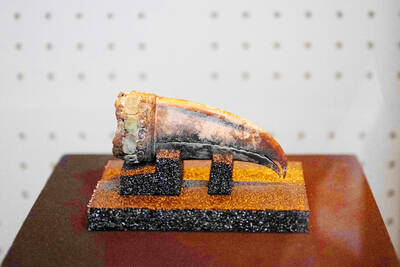North Korea might conduct a nuclear test between South Korean president-elect Yoon Suk-yeol’s inauguration on Tuesday and US President Joe Biden’s visit to Seoul later this month, South Korean National Intelligence Service Director Park Jie-won said yesterday.
If North Korea miniaturizes and lightens its nuclear warheads, short-range missiles can also be equipped with nuclear warheads, and the potential nuclear test is being viewed as very important because it could threaten South Korea and Japan, Park told Yonhap news agency in a telephone call.
His remarks came after the North yesterday fired a suspected ballistic missile designed to be launched from a submarine, South Korea’s military said, apparently continuing a provocative streak in weapons demonstrations that might culminate with a nuclear test in the coming weeks or months.

Photo: AFP
South Korea’s Joint Chiefs of Staff said the launch occurred from waters near the eastern port city of Sinpo, where North Korea has a major shipyard building submarines, but it did not immediately say how far the missile flew.
It also was not clear whether the launch would have involved an actual submarine or an underwater test platform.
The Japanese Ministry of Defense also confirmed the launch, but it did not immediately release flight details.
The launch was apparently North Korea’s first demonstration of a submarine-fired ballistic system since October last year, when it test-launched a new short-range missile from the 8.24 Yongung — its only known submarine capable of firing a missile — in what was its first underwater test launch since 2019.
The launch came three days after the South Korean and Japanese militaries detected the North firing a suspected ballistic missile from near its capital, Pyongyang, on Wednesday, and three days before the inauguration of Yoon, who has vowed to take a tougher approach over the North’s nuclear ambitions.
The latest launch was likely North Korea’s 15th round of missile firings this year, including its first test of an intercontinental ballistic missile (ICBM) since 2017 that demonstrated potential range to reach the entirety of the US mainland.
Experts say the unusually fast pace in testing activity underscores a brinkmanship aimed at forcing the US to accept the idea of the North as a nuclear power and remove crippling sanctions.
There are also signs that North Korea is restoring tunnels at a nuclear testing ground, where it had conducted its sixth and last nuclear test in September 2017, in possible preparations for another explosive test.
North Korean leader Kim Jong-un has punctuated his missile tests with statements warning that the North could proactively use its nuclear weapons if threatened or provoked, which experts say possibly portends an escalatory nuclear doctrine that would create greater concerns for South Korea and Japan.
Kim made one of those statements during a military parade in Pyongyang on Monday last week where he rolled out his ICBMs and what appeared to be a new type of missile designed to be fired from submarines.

ECONOMIC WORRIES: The ruling PAP faces voters amid concerns that the city-state faces the possibility of a recession and job losses amid Washington’s tariffs Singapore yesterday finalized contestants for its general election on Saturday next week, with the ruling People’s Action Party (PAP) fielding 32 new candidates in the biggest refresh of the party that has ruled the city-state since independence in 1965. The move follows a pledge by Singaporean Prime Minister Lawrence Wong (黃循財), who took office last year and assumed the PAP leadership, to “bring in new blood, new ideas and new energy” to steer the country of 6 million people. His latest shake-up beats that of predecessors Lee Hsien Loong (李顯龍) and Goh Chok Tong (吳作棟), who replaced 24 and 11 politicians respectively

Archeologists in Peru on Thursday said they found the 5,000-year-old remains of a noblewoman at the sacred city of Caral, revealing the important role played by women in the oldest center of civilization in the Americas. “What has been discovered corresponds to a woman who apparently had elevated status, an elite woman,” archeologist David Palomino said. The mummy was found in Aspero, a sacred site within the city of Caral that was a garbage dump for more than 30 years until becoming an archeological site in the 1990s. Palomino said the carefully preserved remains, dating to 3,000BC, contained skin, part of the

‘WATER WARFARE’: A Pakistani official called India’s suspension of a 65-year-old treaty on the sharing of waters from the Indus River ‘a cowardly, illegal move’ Pakistan yesterday canceled visas for Indian nationals, closed its airspace for all Indian-owned or operated airlines, and suspended all trade with India, including to and from any third country. The retaliatory measures follow India’s decision to suspend visas for Pakistani nationals in the aftermath of a deadly attack by shooters in Kashmir that killed 26 people, mostly tourists. The rare attack on civilians shocked and outraged India and prompted calls for action against their country’s archenemy, Pakistan. New Delhi did not publicly produce evidence connecting the attack to its neighbor, but said it had “cross-border” links to Pakistan. Pakistan denied any connection to

Armed with 4,000 eggs and a truckload of sugar and cream, French pastry chefs on Wednesday completed a 121.8m-long strawberry cake that they have claimed is the world’s longest ever made. Youssef El Gatou brought together 20 chefs to make the 1.2 tonne masterpiece that took a week to complete and was set out on tables in an ice rink in the Paris suburb town of Argenteuil for residents to inspect. The effort overtook a 100.48m-long strawberry cake made in the Italian town of San Mauro Torinese in 2019. El Gatou’s cake also used 350kg of strawberries, 150kg of sugar and 415kg of